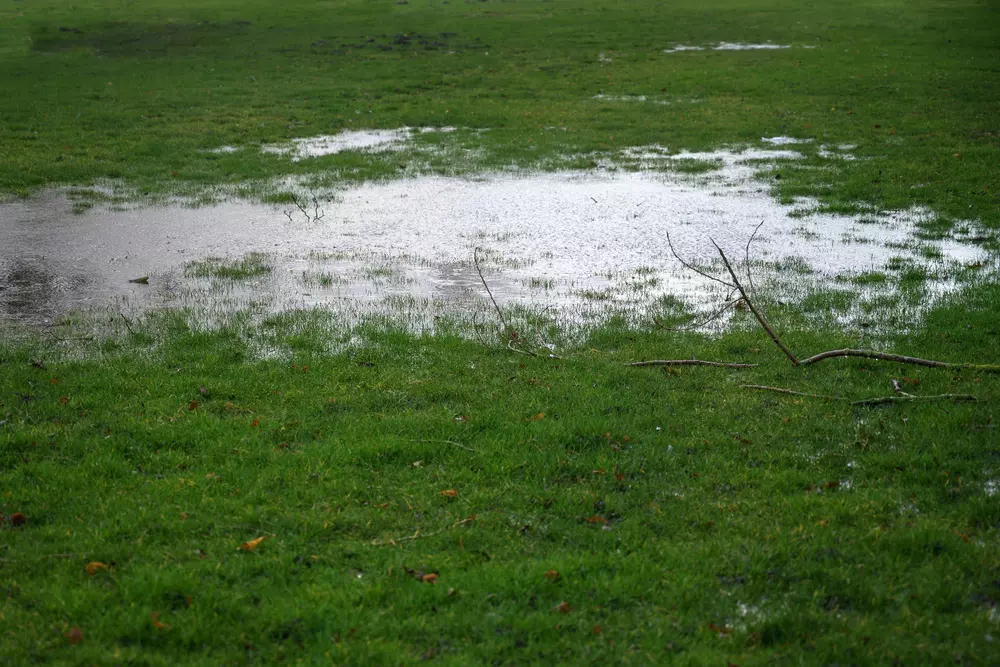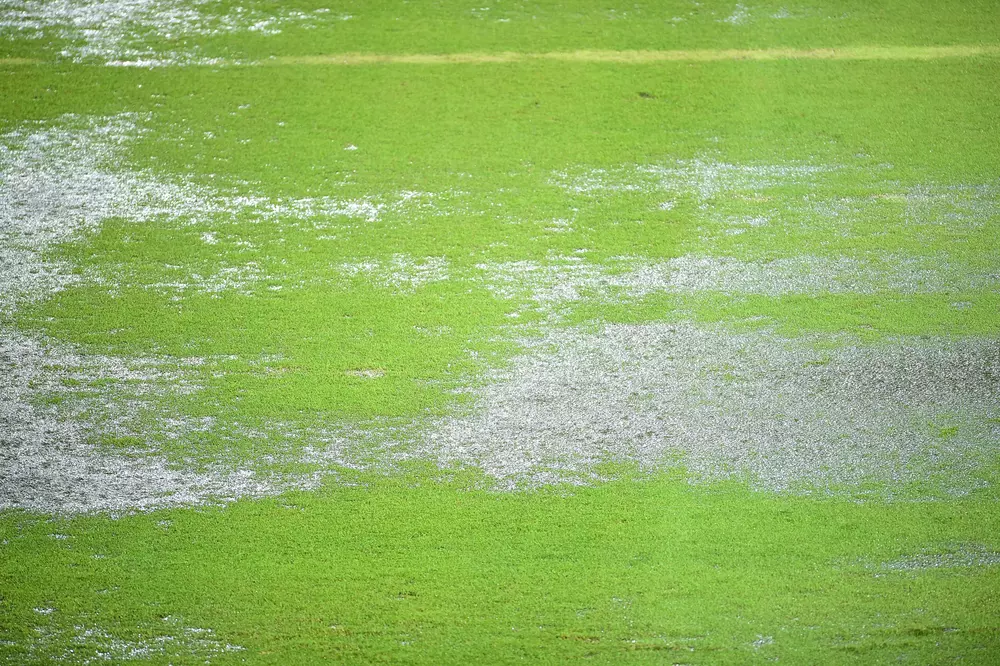
A waterlogged lawn is a sight no gardener ever wants to see. Water is just about everywhere, you can’t even attempt to walk anywhere near it with all the mud about, and all your hard lawn maintenance work seems to have been just washed away.
Although waterlogging can often be caused as a direct result of constant heavy rainfall, there are actually a number of other conditions that contribute to your lawn becoming susceptible.
Here at Hi Quality Turf, having been in the industry for over 45 years we’re well accustomed to waterlogging and all the damage it can cause. We’ve put together this blog to first give our valued customers a background on water logging including what are some of the common causes and symptoms to look out for. Then armed with this information we can begin to tackle this damaging problem.
While there might not be an immediate solution, with the right amount of planning and preventive steps, your lawn will be well on its way to recovery and better protected for the next rainy season.
What Is A Waterlogged Lawn?
Unfortunately these days waterlogging seems to be more of a regular occurrence. Waterlogged lawns occur when the underlying soil is subjected to periods of extended heavy rain. With prolonged exposure, the rainwater has nowhere to escape and sits on the surface of the lawn, failing to drain away through the soil and eventually leaving the lawn underwater.
If these conditions are not alleviated, and plants continue to be submerged for an extended period, this could have dire consequences. As the ground becomes waterlogged and the air spaces get flooded with water, the roots of the lawn are not able to access vital oxygen. If this is not rectified, they slowly start to rot proving to be fatal for the lawn.
Causes of Waterlogging
Before we start delving into appropriate solutions for a waterlogged lawn, it’s important to first understand the causes and how to best identify one. Only then can we begin to devise an effective strategy to counteract it.
Waterlogged lawns can be caused by a variety of factors, and are often due to a combination of conditions coming together. Some of the common causes include:
1. Quality of the soil: Dense compacted soil that may also contain clay is more likely to retain rainwater
2. Improperly prepared soil : Soil inadequately prepared prior to turfing or seeding can make it susceptible to poor drainage
3. A poorly constructed root system : A thick and well-developed root system is a key requirement for a lawn’s ability to absorb water
Common Symptoms of a Waterlogged Lawn
While the most obvious symptom of a waterlogged lawn is its partial or full coverage by water, there are actually a number of other symptoms, the presence of which suggest that your lawn may be waterlogged.
Look out for the presence of these symptoms:
- Surface of the lawn has become covered by a layer of muddy puddled soil
- When walked on the lawn is squelchy
- Blades of grass are showing signs of yellowing, indicating the lawn has been starved of oxygen
- The presence of moss
- The appearance of certain type of weeds that thrive in wet conditions such as cotula and rumex
These are tell-tale signs that your lawn may be waterlogged.
Before you try to repair your lawn, the excess water needs to first evaporate. Avoid walking on the soaked grass, as this will only make the problem worse by squeezing out any remaining oxygen from the soil.
It’s best to wait until the soil has dried to the point of being moist and squishy, you can then begin the vital work to repair your lawn. Let’s see what solutions you’ve got at your disposal.
Aerate the Soil
Aerating your lawn by piercing your soil with small holes will help improve drainage and allow more air to get into the soil, improving the overall conditions for the grass roots to live.
The aeration process can be quite simple and generally requires the use of a garden fork. However depending on how severe your lawn is waterlogged this may require the use of aerator shoes or a hollow tine aerator.
For the most severely affected lawns, it’s recommended to use a hollow tine aerator. This handy tool removes cylinders of soil up to 10-15cm deep. These holes can then be filled with a combination of organic matter and horticultural sharp sand that helps keep the soil loose and draws out moisture, ultimately speeding up the recovery of the lawn.
Add Organic Matter
Organic matter is an ideal solution for breaking up tough and dense soils. Adding compost or other appropriate organic matter is great for improving the structure of the soil and setting up a better foundation for your lawn.
This solution can be used in tandem with aerating. After aerating, apply compost over your lawn, the compost will work its way into the small voids created by aerating and will help to break up any denseness maintaining a more open soil structure. Additionally compost contains beneficial microbes that attract earthworms that work to continue to loosen the soil creating a healthier environment for your lawn.
You can try adding Gypsum over your lawn to help the soil absorb water and break up any dense clay that may be present in your ground.
The amount and make up of organic matter to use will depend on the composition of your soil. In order to get the best results we recommend getting some expert advice from your local garden centre or local turf supplier.
Apply Moss Killer & Fertiliser
Moss killer and fertiliser can be used as an appropriate preventative strategy to help your lawn withstand any future effects of waterlogging.
Wet soil and dead patches of grass are ideal for moss to gain a stranglehold on our lawn. If you start noticing the presence of moss, treat it with a moss killer to prevent the moss from further spreading.
Fertiliser can be used as part of effective preventative strategy to create a healthier lawn. Fertiliser should be used during spring to help the grass regain its green and lush colour after the wet winter season. An added benefit of fertiliser is that it stimulates the development of the root system, helping the grass achieve a greater level of protection against waterlogging.

Improve Drainage
A wet zone can be caused by a combination of factors such as clay soil or low-lying areas lacking a slope. In such instances, an underground drainage system might be the most appropriate solution.
Lawn drainage systems work by transferring water through pipes, from one area to another where water is not likely to build up such as a sloped area or stormwater system.
Although there are many types of drains available on the market that will allow you to collect and divert water away, it’s recommended you use the services of a professional.
Solving drainage issues can be difficult and a professional will be in the best position to implement a solution that can be tailored and unique to your circumstances.
Plant a Bog Garden
A bog garden is a small boggy plot that can help counteract excessive water runoff into a flat area. In the surrounding area to your lawn, you can create such a boggy garden by sowing an assortment of plants that thrive in soggy conditions.
Planting a bog garden can help to soak up any excessive water and creates a tropic look adjacent to your lawn. There are a variety of plants that thrive in waterlogged areas some of which include; astrantia, cardamine, and lysimachia.
Planting a boggy garden in the right location can, not only minimise the effects of flooding, but also provides habitat for birds and pollinator insects.
Dig a Ditch
This may not be a suitable suggestion for every garden but as a last resort, you can dig a ditch at the lowest point of your garden.
This solution works by allowing water to drain into the ditch where it can’t do any damage, minimising any negative impacts to your lawn.
While this solution can be effective, it may not be suitable for all gardens, and works best where the ditch can be placed at the bottom of a slope.
Waking up one morning to discover your lawn has become waterlogged is the definition of many people’s nightmare. Your normally pristine looking lawn is under threat and all your hard work seems to have been washed away.
Fortunately there’s a number of steps that you can take to help repair and alleviate the situation, helping you achieve a better level of protection.
Although a waterlogged lawn is often caused by periods of extended rain, other factors such as the quality of your soil, improperly prepared soil and a poorly constructed root system can all contribute to your lawn becoming susceptible to waterlogging.
Apart from tell-tale signs of over flooding, also look out for squelching underfoot, yellowing of grass blades and the presence of moss. All these signs can help you identify water-logging problems earlier and help you to install preventive measures before the problem gets too bad.
To repair the soil, once the water has drained away, you can aerate the soil with an appropriate tool and treat the area with organic material. The organic material will work its way into the small voids, helping to break up any denseness, maintain a more open soil structure, and attract beneficial earthworms further creating a healthier environment for your lawn.
Once your repair is well underway you can start taking some effective preventative steps.
If you identify the presence of moss, apply moss killer and remember to apply fertiliser to stimulate the development of your lawn’s root system.
For ingrained water logging problems, an underground drainage system might be the most appropriate solution. We suggest using the services of a professional to implement a solution that can be tailored and unique to your circumstances. Finally, depending on the features of your plot you can plant a bog garden or dig a ditch to create more favourable conditions surrounding your lawn.
We hope this blog has been informative and will prove to be helpful next time you start seeing the signs of waterlogging.
Whether you’re a weekend green thumb or a master gardener, everyone can use a little help and the right type of expert advice. If you need further information on waterlogging or any turf related matters, don’t hesitate to contact the experts here at Hi Quality Turf. Having our very own turn farm, we’re uniquely positioned to provide advice from seedling all the way through vital preventive and ongoing lawn maintenance.
For any of your turf needs, why not contact us today.

